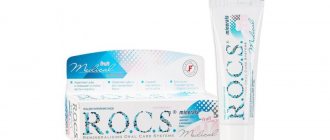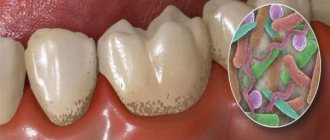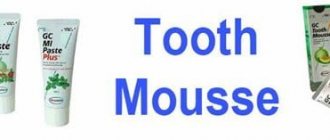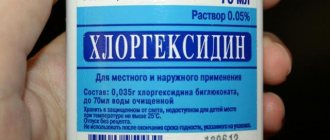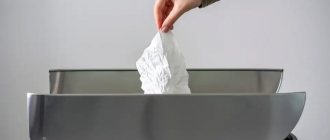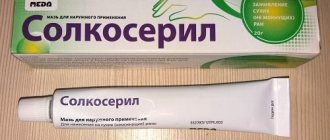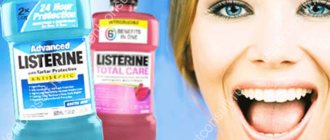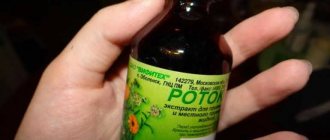Teething is not an easy period for a child, just like for his parents. The process is accompanied by severe discomfort, causing anxiety, itching of the gums, and sometimes even pain and fever. Modern pharmaceuticals have found ways to alleviate the condition. One of the effective drugs for eliminating discomfort during teething is Dentinox gel.
In the article we will discuss in detail the instructions for using the drug Dentinox for children, find out what the properties of the gel are, due to which it gives a positive effect. Let's find out how to use it, whether there are any restrictions on its use.
Don't self-medicate! Be sure to consult with a qualified healthcare practitioner. The information is for informational purposes only and does not replace medical care.
Use in pediatrics
The drug can be used if the child is already one year old. For children under one year of age, Dentinox gel is approved for use only in consultation with a doctor .
Dentinox is not entirely suitable for infants under 10 months of age, as it causes partial numbness of the tongue.
Due to this action, the baby may begin to choke on his own saliva, since his ability to swallow will be partially paralyzed.
In addition to this danger, increased secretion of saliva through the mouth can lead to irritation of the child's skin. Sometimes small children also bite their lips and tongue because they do not feel pain due to numbness.
Composition, release form
Dentinox is a combined composition that looks like a transparent, yellowish, slightly viscous mass.
When applied to the mucous membranes and skin, a clear cool, refreshing and cooling effect is felt, similar to freezing.
Contains chamomile, which has a bactericidal effect. This component is more than others: chamomile is responsible for the positive effect.
Chamomile relieves inflammation and has a disinfecting effect.
The product contains lidocaine , a pain reliever. The Dentinox component has a pronounced freezing effect. It also contains polidocanol, a local anesthetic.
Thanks to the targeted and coordinated effect of these three active components, Dentinox will quickly relieve your baby from suffering during teething.
In addition to the main ingredients listed, there are also auxiliary ones:
- levomenthol with a cooling effect;
- sodium hydroxide;
- sorbitol and xylitol for a pleasant taste sensation;
- propylene glycol for viscosity;
- sodium edetate;
- water and carbopol.
The product goes on sale in standard tubes made of medical aluminum. Each package includes detailed instructions for use.
Pharmacological properties of the drug Dentinox-gel n
Local anesthetic of plant origin. When using the herbal remedy of chamomile infusion, the anesthetic lidocaine and polidocanol 600 (macrogol lauryl ether) in a low dose specially selected for children, pain during teething of baby teeth is eliminated. Chamomile infusion: a herbal remedy with anti-inflammatory effects in a standardized pharmaceutical form. Lidocaine hydrochloride: an anesthetic used topically in a safe dose (0.34%). Polidocanol 600 (macrogol lauryl ether): local anesthetic, is well retained on the oral mucosa and has a long-lasting therapeutic effect. Dentinox-Gel N is better distributed and stays on the mucous membrane longer. The drug does not cause dental caries.
Properties and action
Dentinox is capable of simultaneously:
- relieve pain;
- eliminate germs;
- relieve inflammation.
We note that it is safe for children : the gel does not penetrate the circulatory system, therefore it does not have a systemic effect on the body.
Due to the complete absence of sugars and preservatives, it does not harm the health of infants.
Has a pronounced analgesic effect. The gel can be used even when there is damage to the oral mucosa. The composition does not contain benzalkonium chloride, so the product will not cause harm in case of perforation of the mucous membrane.
Dentinox gel has a prolonged effect due to the carbopol contained in the composition. Compared to many other analogues, the period of positive impact is really excellent.
Disadvantages - weak anti-inflammatory effect in the presence of ulcerations on the child’s oral mucosa.
And in order to eliminate stomatitis, which often accompanies the process of teething, treatment with other drugs will be required.
pros
Let's find out what the positive features of the product are.
Firstly, the composition does not contain sugars harmful to the baby’s body . To give the substance a pleasant taste, it included xylitol and sorbitol, which successfully cope with their task.
The product does not negatively affect the condition of children's first teeth.
It can also be used for irritated mucous membranes, since there are no additional irritating substances in the composition.
The analgesic effect is very pronounced, and the child calms down very quickly: a few minutes after applying the product. Thanks to lidocaine, the composition acts as a local anesthetic.
The product is non-toxic and does not create a sticky adhesive effect in the mouth. Can be used when a child is teething both milk and permanent teeth.
Indications and contraindications
The drug Dentinox is used in pediatrics to alleviate the condition of the baby during teething.
Relieves pain that often accompanies the eruption of baby and molar teeth. The product relieves inflammation, eliminates swelling of the gums and redness.
Cannot be used in the following cases:
- in case of intolerance to components;
- if you are sensitive or allergic to chamomile;
- if the baby is not yet one year old.
We will talk about the effectiveness of other dental ointments:
- Cholisal-gel - used for teething.
- Kamistad - will help with diseases of the oral cavity.
- Rox - used to strengthen, whiten teeth, and prevent caries.
- There you will also learn about the most popular pain-relieving gels for teething and toothache.
Indications for use of the drug
Primarily due to the composition, it has an antiseptic and anesthetic effect. The drug also has an anti-inflammatory effect. It acts exclusively locally and is used strictly according to the instructions. Thanks to the composition, it significantly facilitates the process of teething of primary and primary teeth, as well as incisors. Accordingly, the drug is used in infants and children of the first year of life during teething in order to simultaneously prevent inflammatory processes and pain.
The drug is safe in its composition and does not cause allergic or other negative reactions. No side effects were identified in the instructions or during the research process. The gel can be stored for up to 5 years, but the solution can be stored for only 3. But after opening the package, the shelf life is reduced to 1 year, which in principle is quite sufficient for a specific drug and the age of the child.
In simpler terms, the medication is used mainly for the prevention of inflammatory-infectious pathologies, increases local immunity thanks to chamomile extract, and also has a time-limited analgesic effect. Dentinox gel helps eliminate irritation by acting on nerve receptors in the soft tissues of the gums. This, in turn, improves the overall well-being of the baby.
How to use
Dentinox is very easy to use. Below we will provide a detailed diagram of the application of this drug.
Dry the gums a little with a sterile cloth. This is done so that the drug is not immediately swallowed and has time to exert its beneficial effect.
Squeeze out a small portion from the tube, about the size of a pea. Then a cotton swab or a clean finger is dipped into the mixture and the product is applied to the child’s gums.
The baby should not drink or eat for five minutes after the procedure: this measure will help the drug stay on the gums longer so that the components have time to take effect.
Apply the product three times a day , no more. The optimal time for the procedure is after meals and at night. The duration of the course is not limited: Dentinox can be used as long as the child is teething.
How to apply
Dentinox is usually applied two to three times daily unless otherwise directed by your doctor. Application time: at night, after eating and drinking.
The application scheme is as follows:
- the gums need to be dried with a gauze swab or napkin;
- squeeze a little gel onto your finger;
- Use a cotton swab or your finger to apply the product to the child’s gums, rubbing it in.
Attention! If you missed the application, then next time a double dose of the product is unacceptable: apply the drug as usual.
Application
For stomatitis or pain, Dentinox is applied as a solution as follows:
- The hands of the person who will apply the product must first be washed with soap.
- Next, depending on the application method, drop the solution onto a cotton swab or onto a clean finger. 3 drops are enough.
- Smear the gums in the teething area with light massage movements for 30 seconds - 1 minute.
If necessary, both types, both Dentinox baby in drops and the gel, can be alternated and used during this period of teething, both primary and primary. When using gel the principle is the same:
- Wash your hands thoroughly.
- Apply the product onto your finger or cotton swab. Literally one drop, which is the size of a small pea, is enough.
- Rub the mixture into the gum where the tooth is erupting. Do this without pressure, as carefully, carefully and easily as possible.
Next, wash your hands from the product and close the bottle or tube. The procedure can be performed up to 3 times a day and only after meals, as well as before bedtime. The product is applied only in the presence of pain, if the child has a hard time with the teething process. If you are unsure about the regimen for using the medication, consult your doctor first.
Make sure that the tip of the dropper or the area around the entrance of the tube does not touch the skin. Otherwise, there is a risk of contamination of the contents.
If you forget to apply Dentinox Baby to the treatment area, then under no circumstances should you apply a double dosage. This can cause severe side effects. If a dose is missed, simply continue to use the medication according to the standard regimen after the next feeding.
When will the effect take place?
The composition has the taste and smell of chamomile and is quite pleasant, so the baby lets you apply it calmly.
The positive analgesic effect occurs quickly and lasts approximately two hours. Some parents find this period of time too short, but for minor discomfort the drug may be helpful. The gel has a calming effect: after applying it, children fall asleep well.
If Dentinox does not have the expected positive effect, you should consult your pediatrician. Most likely, the specialist will prescribe a different drug.
Side effects
The gel is theoretically capable of causing allergic reactions of the following nature:
- burning sensation;
- skin rashes of diathesis type;
- irritation of the oral mucosa.
In severe cases, Quincke's edema is possible.
If any allergic reaction occurs, application should be stopped immediately. Then rinse the gums with water and consult a doctor.
If you use the composition in recommended doses, the likelihood of side effects is extremely low.
An overdose increases the effect of the medicine: severe numbness of the tongue may develop, and swallowing becomes difficult.
Saliva is produced abundantly : there is a danger that the baby may choke. It is important to prevent abuse of this drug.
Contraindications, side effects
Instructions for use of Dentinox show that direct contraindications to the use of the product are:
- Allergy to chamomile extract and asteraceae;
- Allergy to lidocoine or related pain relievers;
- Allergy to other components of the drug;
- Fructose intolerance.
The use of Detinox with other foods and drinks does not require any restrictions. But you should follow the application rule: only after meals or just before bed. Avoid contact of the solution or gel with the eyes.
The use of the drug during lactation is not prescribed in the instructions, but it is known that it is used to relieve pain during the first eruption of different types of teeth. There is no information on use during pregnancy, since no relevant studies have been conducted.
If a larger amount of the drug was applied to the gums, then the side effects appear with greater force. In such an incident, the use of the drug is canceled completely, as well as its analogues. Next, show the child to the doctor and describe the situation. Side effects may appear in the form of local allergic-type reactions:
- Irritation;
- Hives;
- Increased sensitivity of the treated area.
In case of overdose, the following may also occur:
- Tissue swelling;
- Erythema;
- Angioedema;
- Bronchospasm;
- Anaphylactic shock (this occurs in exceptional cases).
Systemic exposure is unlikely since only a small amount of lidocaine enters the bloodstream. But nervous excitement, dizziness, loss of consciousness, insomnia, respiratory paralysis, decreased blood pressure, cardiac arrest, bradycardia, and myocardial depression can still occur with oral administration (that is, when a large amount of the drug is ingested).
If a side effect occurs, you should immediately stop using the drug, since lidocaine is considered an allergenic substance and can, under certain conditions, cause serious pathological conditions. If signs of angioedema appear, then the use of oral antihistamines is prohibited due to the risk of suffocation. It is necessary to immediately call an ambulance, which will help eliminate the consequences of an overdose or the development of an allergic reaction.
In general, there are no known cases of overdose or side effects at the moment, but if any undesirable reactions occur on the part of the child’s body, the use of the drug should be stopped. It is worth understanding that a child’s body is more sensitive to allergens and reacts to them more acutely.


